Job hunting is all about making a strong impression, and your CV is the tool that showcases your work history and skills to employers. Think of your CV as your personal highlight reel for the job market. Knowing how to highlight your strengths isn't always easy, however, and you'll need the right CV format to illustrate your professional potential.
In this guide, we’ll review the following curriculum vitae formats: reverse chronological, functional, and combination. Understanding these formats allows you to select the CV format that best highlights your career story.
We’ll explore the following:
- Our top CV formatting tips
- The essential sections to include in your CV
- Our best CV format examples
- Reverse chronological CV format
- Functional CV format
- Combination CV format
- The pros and cons of each CV format
- International CV formats
Let’s begin with the best ways to format your CV!
How to format a CV:
In simple terms, a CV format is the structure of your professional profile, tailored to showcase your background to potential employers effectively. The best CV format for you depends on a few things: mainly the job role you’re applying for, your professional skills and career experience.
We’ll dive deeper into each individual CV format, but it’s important to remember that every CV format is optimised for different career backgrounds and job roles. The best CV format for you is the format that can best convey your career strengths and the professional value you can offer to employers.
Before we explore the three main CV format types, here are some other important tips for job seekers to consider:
- Keep your CV brief: 1-2 pages is best
- Choose a professional font such as Arial, Times New Roman, or Calibri. We recommend using a font size of 11-12 for the body text, adjusting slightly depending on your chosen font
- Make headings 4-6 points larger than your body text for a clear distinction
- Set your page margins to approximately 2.5cm (1 inch) for a neat layout
- Including a photo in your CV isn't a common practice in New Zealand, so keep the headshots for LinkedIn or Instagram!
- Save your CV in PDF format to ensure the layout stays consistent across different devices, unless employers specify an alternative format
Without further ado, let’s check out the three main CV formatting options!
Main CV Format Types
- Reverse Chronological CVs: The reverse chronological CV format is the most common and widely recognised CV format, perfectly suited for those with a consistent and continuous employment history. This CV format lists your professional experience starting with your most recent position and working backwards. It offers a clear timeline of your career progression, making it easy for employers to follow your professional growth. By highlighting the where and when of your career milestones, this CV format is a great choice for candidates with a consistent employment record.
- Functional CVs: Functional CV formats help candidates stand out by focusing on the skills and experience relevant to the job you're applying for, rather than the chronological order of your work history. This CV format highlights professional skills and accomplishments at the beginning of your CV, and usually features a prominent ‘Skills’ section. It's a great choice for those with gaps in their employment history, career changers who’d like to highlight transferable skills, or recent graduates with more academic or voluntary experience than formal work history. The functional CV strategically packages your skills, painting a picture of you as a well-suited professional.
- Combination CVs: A combination CV merges elements of both the chronological and functional CV formats, offering a versatile platform to showcase both your work history and your skills. This CV format, otherwise known as a hybrid CV format, typically begins with a detailed section emphasising your key skills and achievements. It usually follows with a reverse chronological work history. The combination CV is ideal for individuals looking to draw attention to specific skill sets or those transitioning into new career paths where their transferable skills are a primary selling point.
As you can see, each CV job format offers different advantages. We’ll help you choose the CV format that best presents your professional profile and enhances your chances of landing your next job role.
Review the job description and requirements thoroughly. Before choosing your CV format, read the job description carefully. If employers are looking for professionals with a particular skill set, it could be best to use a functional or combination CV format.
If the job requirements are more focused on your employment history and professional experiences, a reverse chronological CV might be your best bet. We’ll explore each individual CV job format, but it’s important to remember that the job description can offer many important clues as to what employers are directly looking for.
Reverse Chronological Format:
The reverse chronological CV job format is favoured for its straightforward style, popular among employers and job seekers alike. As we mentioned earlier, it presents your employment history and accomplishments, starting with the most recent position and working backwards.
This clear structure makes it easy for employers to see your latest achievements and understand how your career has developed over time. It's a simple yet effective way to demonstrate your professional journey and the experiences that have shaped your expertise.
This CV format is not just about listing jobs; it also includes your education and key skills, all in reverse order. The focus is on clear presentation and ease of reading, allowing anyone looking at your CV to quickly get the gist of your qualifications and work history. For individuals with a solid work background and a clear career progression, the reverse chronological CV can be a powerful tool to highlight their growth and suitability for the job at hand.
Check out our example of a reverse chronological CV format below:
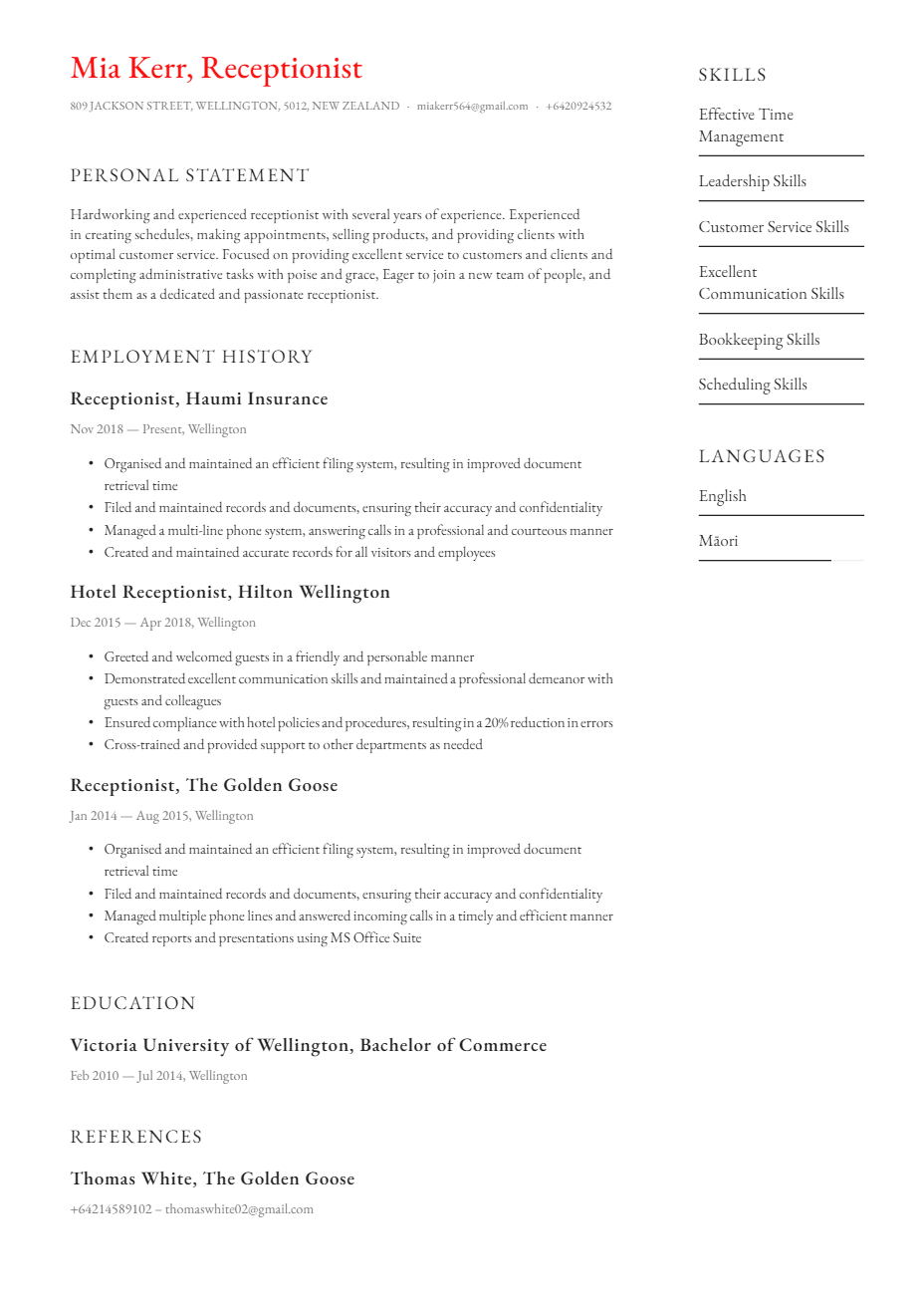
Every great reverse chronological CV format typically contains the following:
- A CV header that lists your contact details
- A compelling personal statement, otherwise known as a professional summary
- Employment history, with positions listed in order of most recent to least recent
- Relevant skills, including any interpersonal skills, technical skills or hard skills you possess
- Education section, including any degrees, qualifications or relevant certifications you may have
Let’s begin with choosing an appropriate CV header.
CV Header
Your CV header is likely the very first thing employers will see on your CV, so it's important to choose a visually appealing header that's appropriate for your industry. Include your full name in a large, bold text, so that it stands out as the header's main feature. Right underneath your name, write the job title you're applying for, and add your contact information: a current phone number and an email address where employers can contact you quickly.
If you have a LinkedIn profile or any links to a professional website, include those links here, too. Keep it simple and focused on how employers contact you and learn more about your work. Personal details like your age or relationship status aren't needed in this section. Take a look at our teacher CV format example below for a great CV header:

Personal statement
Your personal statement is a brief and dynamic pitch about who you are as a professional and the potential value you bring to the table. It should be positioned right underneath your CV header, and efficiently align any skills and experiences you possess with the job you're applying for. In about 2-3 sentences, highlight your most relevant qualifications, professional achievements, and the unique traits that make you ideal for the position.
Your personal statement is also your chance to grab the employer's attention by showcasing your enthusiasm and the value you can add to their team. Keep it genuine and avoid clichés to help leave a memorable first impression. Check out our nurse CV format example and writing guide for a great example of a personal statement:
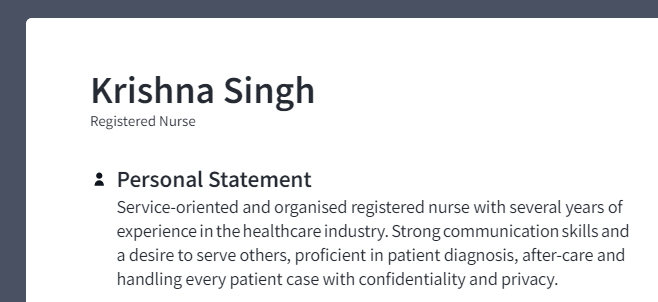
Employment history
The employment history section is a detailed record of your professional journey. Here, list your past jobs in reverse chronological order, starting with the most recent position. For each role, include your job title, the company name, the dates of employment, and a summary of your responsibilities and achievements. Be concise but informative, focusing on experiences and accomplishments that are relevant to the job you're applying for.
Use action verbs to make your duties come alive and numbers to quantify your successes when possible. This section is key to showing potential employers the trajectory of your career and your capability to add value to their organisation. We’ve got a great example of an employment history section in our academic CV format example below:
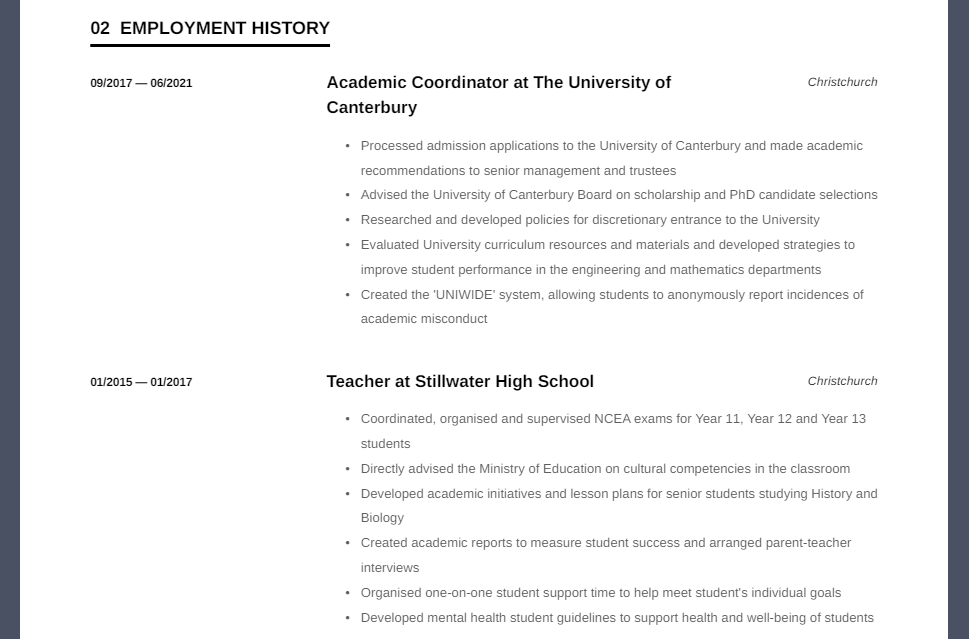
Skills
The skills section of your CV should showcase your abilities that are most relevant to the role you're applying for. For example, if you’re applying for the role of a farm hand, you should probably avoid including your flash rugby or typing skills! The skills section should be easily scannable and grouped into relevant categories if you have a wide array of skills.
Include a mix of hard skills and soft, interpersonal skills, prioritising those most in demand for the job. Be specific – for example, rather than "good with computers," write "proficient in Adobe Creative Suite." This section helps employers quickly see that you have the qualifications they're looking for. Check out our programmer CV format example below for inspiration on how to format your CV skills section.
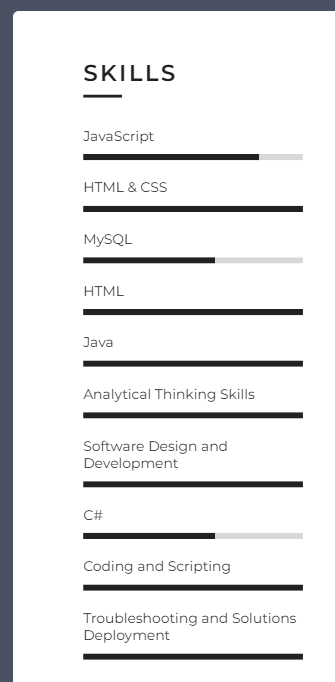
Did you know that high-income skills such as digital marketing or data analysis can earn Kiwi jobseekers more than $80,000 per year? Including a wide range of hard, technical and soft skills can help you stand out in a sea of applicants and get you noticed, and hired, faster!
Education
The education section of your CV outlines your academic qualifications and should be tailored according to the level and relevancy of your educational background to the job you're applying for. List your highest degree first and descend to the least advanced degree. Include the name of the institution, the degree obtained, your field of study, and graduation date.
If you're a recent graduate or have limited work experience, you may also include academic achievements, relevant coursework, or extracurricular activities that demonstrate transferable skills.
If you've been in the workforce for a while, keep this section brief and focused on your highest qualifications. For more help with formatting your education section, take a look at our veterinarian CV format example to help get you started.

Using a reverse chronological CV job format is a great way to highlight your career trajectory and allows potential employers to effectively map your career progression. It’s also an easy way for employers to assess if you’re a good fit for the job role.
It’s important that the career experiences you include on your CV are not just in order of most recent to least recent, but that your past professional experiences are arranged in a way that emphasises the value you can offer to the job role. Keep in mind that employers are interested in seeing how your expertise and experience directly relate to the role in question.
That means that if you’re applying for a chef position and have already had multiple jobs in the hospitality industry, it’s best to leave your job role in retail from eight years ago. Employers are looking for relevant experience and expertise – so if you have more relevant career experiences, prioritise highlighting those first.
Here are some of the main advantages of using a reverse chronological CV format:
- Shows a clear timeline of work history, emphasising career growth and progression
- Easy to scan by recruiters and hiring managers
- Simple to add new jobs or updates, keeping the CV current
- Allows for the prominent display of recent educational achievements and certifications
- Aligns well with Applicant Tracking Systems, which may aid in the job application process
Functional CV Format:
Functional CV formats emphasise your skills and achievements instead of focusing solely on your previous job positions. Usually, you can opt for a functional CV format when you want to draw away from gaps in employment history, if you have limited job experience, or when you’re changing career paths or industries and want to focus more on skills and achievements you’ve accrued over the years.
In a functional CV format, you’ll typically include a skills summary at the top of the CV, followed by specific skill sets and accomplishments. You can use your cover letter to elaborate on your career and explain any gaps in your work history, but your CV should highlight your skills and achievements as convincingly as possible. Remember: the goal of a CV is to showcase the value you can offer employers, even if you gained these skills in different industries or through less traditional means.
A functional CV, sometimes known as a skills-based CV, can provide several advantages, especially for certain job seekers.
Functional CVs have the following benefits:
- Concentrating on your skills and abilities instead of a chronological work history, a functional CV is ideal for those with limited work experience to showcase
- Functional CVs can help jobseekers transition to new careers by spotlighting transferable skills.
- Recent graduates benefit from a functional CV format as it allows them to bring attention to relevant skills gained outside of employment
- Using this format can underscore professional growth by showing accumulated expertise and ongoing development
- Lastly, functional CVs offer a clear and concise demonstration of a candidate's strengths for hiring managers
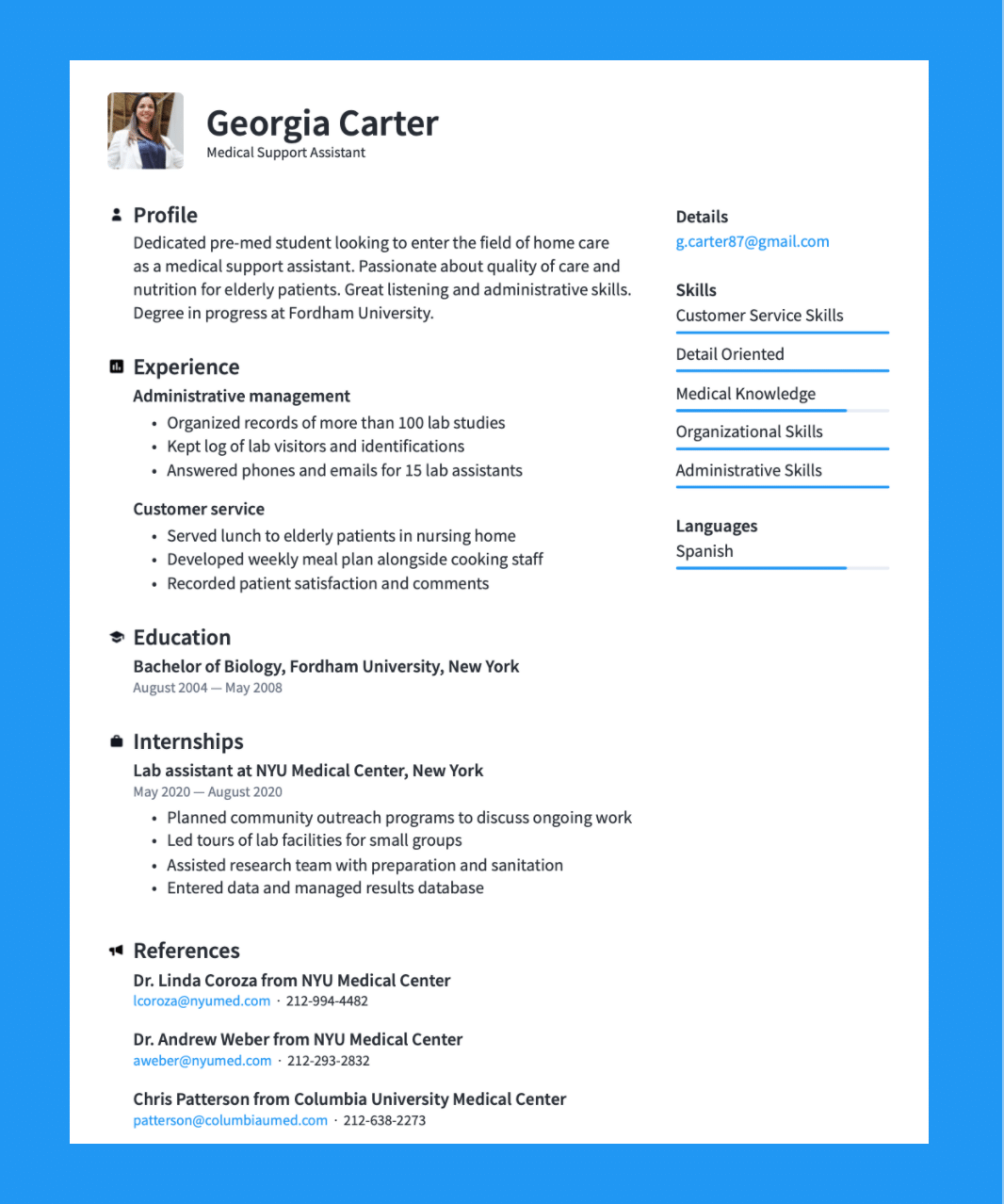
Combination CV Format:
Combination CV formats, as the name suggests, offer individuals the opportunity to present a comprehensive overview of both their skills and professional experiences.
This format is particularly beneficial for freelancers, IT professionals, and those in marketing roles, allowing applicants to highlight their work history and any relevant skills or achievements that make them a well-rounded candidate. In a combination CV, there are generally two key sections that you can use to your advantage.
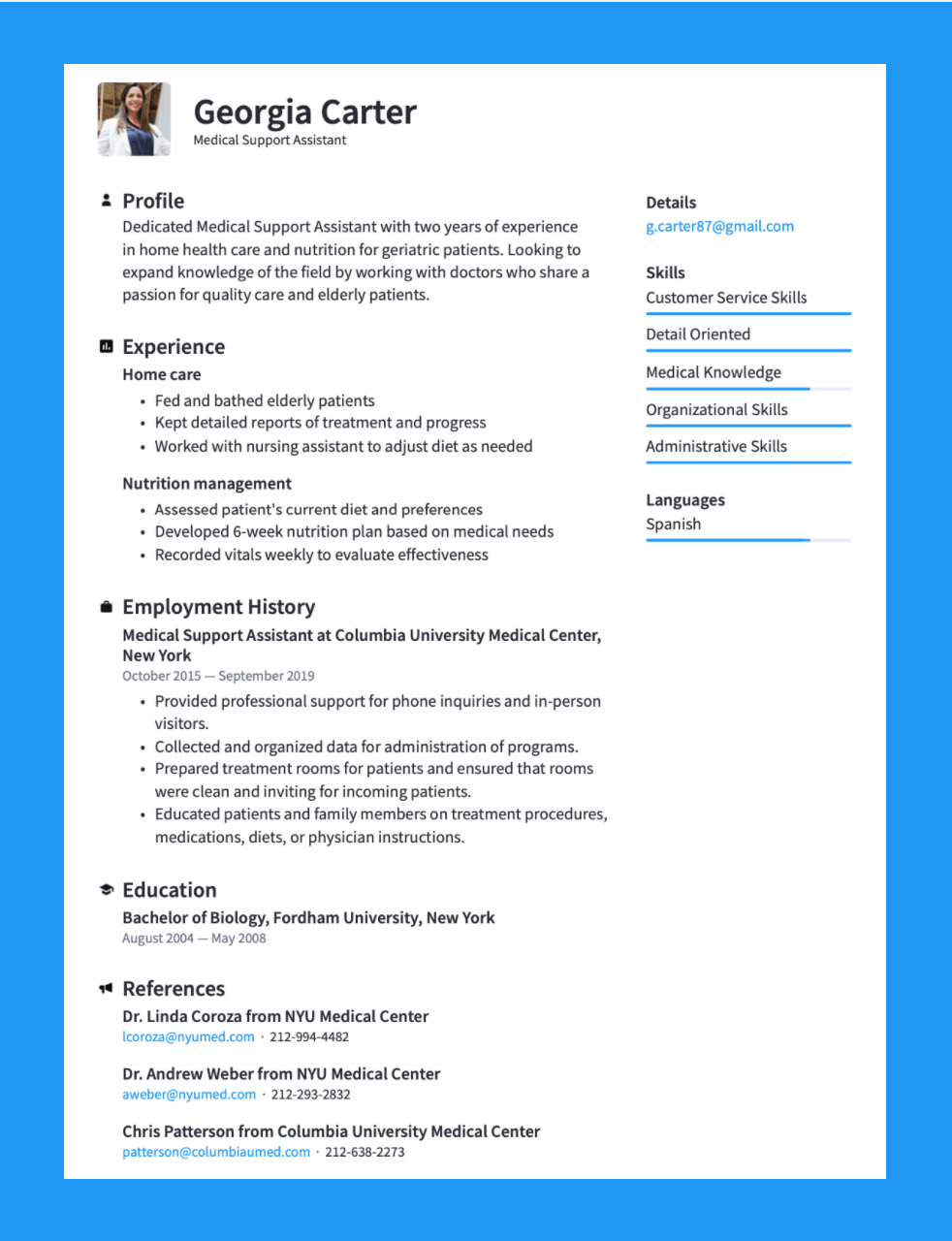
The first section is the skills summary section, which allows you to showcase your core professional strengths and areas of expertise. Here, you can list the specific skills, tools, software, or methodologies that you have mastered in your career. This section can provide a snapshot of your abilities, making it easier for potential employers to quickly grasp your skill set.
The second important section in a combination CV is the employment history section. This is where you can outline your professional journey and highlight relevant experiences and achievements. This section allows employers to see the practical application of your skills and the impact you’ve achieved in previous positions.
Combination CVs are effective at capturing an applicant’s job experience and skillset and help highlight your professional value to employers.
Combination CVs have the following advantages:
- Balances skills and work history, making it ideal for those with solid experience and relevant skills
- Useful for individuals with a strong work history looking to transition to a new field, as it showcases a commitment to the profession while also emphasising applicable skills
- Provides context for skills by tying them to specific roles and experiences, which can make them more meaningful to employers
- Shows a pattern of career progression, which can be appealing to employers looking for candidates with growth potential.
- Suitable for IT professionals or those in creative industries where a combination of technical skills, creativity, and experience is key
The best CV formats for New Zealand
If you're an international applicant looking to apply for positions in New Zealand, it's essential to understand the local job market preferences when it comes to CV formatting. New Zealand employers typically prefer a clear and concise CV that outlines your experiences and qualifications in a straightforward manner.
Fortunately, the reverse chronological CV format is highly appreciated in New Zealand as it provides an easy-to-follow timeline of your professional journey, showcasing your work history from the most recent role to the older ones.
If you’re a job seeker from Europe, the format is similar to what you’d see in a Europass CV. This format not only highlights your recent accomplishments but also allows potential employers to quickly assess your career development and the relevance of your experience to the position you're applying for.
Adapting your CV to the reverse chronological format can greatly improve your chances of capturing a New Zealand employer's attention. It's important to remember that New Zealand CVs generally place a strong emphasis on practical experiences, key achievements, and specific skills that align with the job requirements.
In addition to your employment history, incorporating a section that includes your education and professional certifications is recommended, especially if they are relevant to the job. By presenting your information in a clear and professional manner, you can make a strong impression, demonstrating that you’re well-prepared to enter the New Zealand job market.
When an Applicant Tracking System (ATS) reviews your CV, it's important to use common section headings and to include important keywords all over your CV. The order of the headings isn't very important, but you should always have a section for your employment history, even in a non-traditional CV
Top 2025 CV formatting trends
In 2025, Kiwi job seekers are adapting their CVs to match a dynamic job market. While many still use the classic reverse chronological CV, others are starting to see the benefits of alternative formats, such as the functional CV and combination CV formats.
Below, we've included three major CV formatting trends that are shaping the New Zealand employment landscape in 2025:
- Emphasis towards specialised talent
- Freelancing continues to thrive
- Graduates highlighting potential over experience
- An increased focus on specialised job applicants: As echoed by recent insights from the University of Waikato, a need for specialists, such as doctors and medical professionals is growing. Industry professionals even point to a shortage in some careers and a growing reliance on foreign workers to meet these growing needs. Professionals with more niche, specialised expertise may find a combination CV allows them the space to highlight their in-depth knowledge alongside key career achievements.
- A move towards freelancer-friendly CV formatting: Freelance careers can allow job applicants more flexibility and time freedom, and according to StatsNZ, at least 1 in 20 employed Kiwis are contractors or freelancers. This aligns with global trends suggesting that more workers are choosing freelance jobs in a range of areas, including graphic design, digital marketing or accounting. Functional CVs are often best for freelancers since they highlight skills and professional experiences rather than a chronological work history.
- More graduates focused on emphasising potential over experiences: 2020 to 2025 presented unconventional obstacles for students and graduates, leading to missed opportunities in internships and volunteer work that would traditionally support their transition into a steady career. Now, New Zealand employers are beginning to look beyond experience and consider a graduate's potential. For this reason, recent graduates are turning to functional or combination CV formats that emphasise their skills and future capabilities.
Key Takeaways
When placing the finishing touches on your CV, it's essential to select a CV format that most effectively showcases your professional potential. So remember:
- Choose a CV format that highlights your experiences and skills in a way that reflects your potential for the role you’re applying for
- Review the job description to identify the key skills, traits, or experiences employers are looking for, and ensure you mirror these in your CV
- Consider the advantages and drawbacks of each CV format; whether it's a reverse chronological CV format, functional CV format, or a combination CV format, each has its benefits depending on your career history and the job role
- Fine-tune your CV to be ATS-friendly, incorporating relevant keywords and maintaining a clear structure with conventional headings to enhance its readability by automated systems




